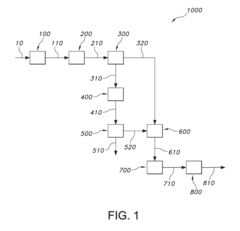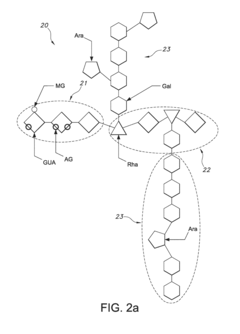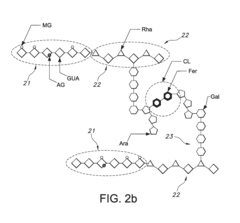Coffee pulp preservation and extraction process
a technology of extraction process and coffee pulp, which is applied in the field of coffee pulp treatment process, can solve the problems of inability to commercially prepare and recover these compounds, high concentration of toxic substances, and insufficient biomass, so as to reduce the dissolution of valuable compounds, maintain the integrity of the cellular wall, and good mixing
- Summary
- Abstract
- Description
- Claims
- Application Information
AI Technical Summary
Benefits of technology
Problems solved by technology
Method used
Image
Examples
example 1
[0096]Extraction and Modification of Pectin from Coffee Pulp Laboratory Scale Procedure:
[0097]Fresh pulp was obtained directly from a farm in Colombia in the beginning of January 2012. The cherries were in optimum ripe state to be separated from the bean in the wet mill. After the recollection the skin and pulp (exocarp and meso carp) were separated with a manual. The pulp, skin (pulp) are blended and freeze dried for transport to The Netherlands. 1 g of freeze dried material is washed 3 times with acidified ethanol 80% and centrifuge at 3000 rpm for 5 min in each step, the solids are then suspended in water, the pH is adjusted to 2.0 with hydrochloric acid and fill to 50 ml volume. The suspension is shaken in a water bath at 70° C. for 3 h. The suspension is then centrifuged at 3000 RPM for 10 min and the aqueous phase is separated from the solids. The solids are then neutralized and Sodium hydroxide is added to adjust pH at 10 and a final volume of 50 ml. The solids are suspended ...
example 2
[0098]The following procedure for obtaining soluble polysaccharides from coffee pulp, with certain degree of polymerization here after called pectin, this procedure is intended as a guide. Therefore modifications can of course be chosen.
Materials:
[0099]Coffee pulp (including coffee pectin): Coffee pulp from the variety Coffea Arabica was obtained fresh (coffee cherries were purchased directly from a farm in Colombia from the harvest of December 2011); Peroxidase from horseradish: Peroxidase from horseradish (HRP) was purchased from Sigma Aldrich EC 1.11.1.7 200 U / mg, Hydrochloric acid, sodium dihydrogen phosphate and sodium hydroxide of analytical grade were purchased from Merck Dramstad Germany.
Method:
[0100]The coffee cherries were washed with water and the pulp was removed from the beans and parchments manually. The pulp was immediately macerated in a conventional blender at high speed and freeze-dried.
Clean Up Procedure (Washing Procedure):
[0101]1 g of coffee pulp was washed thre...
example 3
Experiment Data:
[0112]The following experiments were performed with freeze dried samples of coffee pulp (exocarp and mesocarp). The experimental design was as follows: (1) Preparation of freeze dried coffee pulp (FD-coffee pectin): 100 g of FD-coffee (i.e. freeze-dried coffee pulp) pectin was milled in a Retsch ball mill to a particle size that passes through a 6 mm mesh. (2) FD-coffee pectin was homogenized in demineralized water in one liter of water; the pH was adjusted to low pH using Hydrochloric acid (HCl) 37%. The acid was added drop wise. (3) The suspension was placed in a water bath at the correct temperature with continuous shaking for the exact period of time. (4) The suspension was then filtered hot through cheese cloth; the cloth was squeezed by hand to remove most of the liquid from the solid mass. (5) The solid mass was then homogenized with 0.5 l of water and the pH adjusted with NaOH 4M the alkali was added drop wise. (6) The suspension was placed in a refrigerated ...
PUM
| Property | Measurement | Unit |
|---|---|---|
| temperature | aaaaa | aaaaa |
| temperature | aaaaa | aaaaa |
| temperature | aaaaa | aaaaa |
Description
Claims
Application Information
 Login to View More
Login to View More - R&D
- Intellectual Property
- Life Sciences
- Materials
- Tech Scout
- Unparalleled Data Quality
- Higher Quality Content
- 60% Fewer Hallucinations
Browse by: Latest US Patents, China's latest patents, Technical Efficacy Thesaurus, Application Domain, Technology Topic, Popular Technical Reports.
© 2025 PatSnap. All rights reserved.Legal|Privacy policy|Modern Slavery Act Transparency Statement|Sitemap|About US| Contact US: help@patsnap.com



